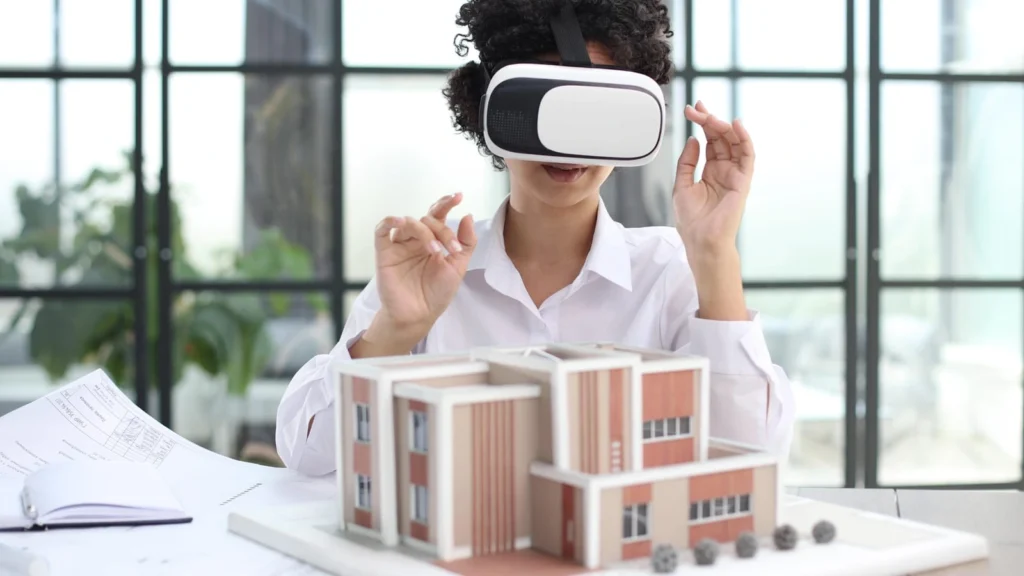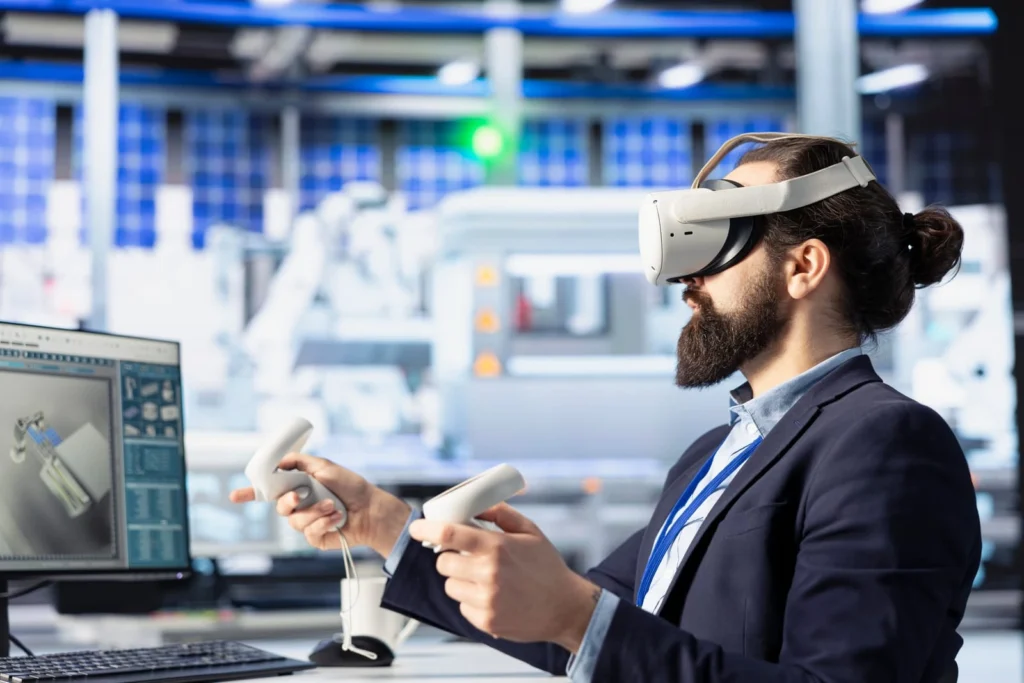
Imagine walking through a space that hasn’t been built yet — stepping inside, looking around, and experiencing every detail. That’s not science fiction anymore. Thanks to VR architecture, architects and designers are changing how we interact with ideas long before construction begins.
From speeding up approvals to transforming client relationships, VR is no longer just a novelty. It’s becoming one of the most useful tools in the architectural process — and this article explores why.

VR in architecture refers to the use of immersive technologies to simulate 3D environments. Architects can now take their designs and render them into full-scale, interactive models that clients, contractors, and colleagues can explore in real time. This goes far beyond traditional renderings or flythrough animations — it brings the design to life.
Whether you’re developing a commercial building, a home, or a mixed-use development, VR helps everyone involved see the finished product long before construction begins.
To understand VR’s unique role, it helps to distinguish it from other technologies:
While all of these tools help communicate design, VR offers the most immersive and intuitive experience.
Behind the scenes, specialized software powers the magic. Tools like Enscape, Twinmotion, Lumion, and Unreal Engine allow architects to convert 3D models into VR-ready environments.
These tools don’t just add visual polish. They offer:
By using these platforms, designers can quickly shift from design mode to presentation mode, without rebuilding the model from scratch.
Whether you’re developing a commercial building, a home, or a mixed-use development, VR for architecture helps everyone involved see the finished product long before ground is broken. It gives clients, engineers, and stakeholders a clear, shared vision, which leads to better feedback, faster decisions, and smoother builds.

For decades, architects have relied on blueprints, floor plans, and static 3D models to communicate design ideas. But let’s face it — not everyone can interpret those visuals easily. Clients often nod along, unsure of what the finished space will feel like. That disconnect leads to confusion, second-guessing, and revisions down the road.
VR changes the game. Instead of trying to imagine how a space might look or flow, clients can step into it. They can explore every corner, walk from room to room, and look around as if they were physically there. The sense of scale, lighting, and movement becomes real. This emotional connection fosters trust between the architect and client because the client finally understands.
With VR, abstract designs become tangible experiences. It’s no longer about just showing a vision; it’s about letting the client live in it, even if just for a moment.
When clients truly understand the design from day one, everything else becomes easier. Instead of endless back-and-forth emails or long meetings to explain layout changes, clients can instantly point to what they like — or don’t like — inside the virtual space. It shortens feedback cycles dramatically.
Imagine a client walking through a virtual apartment and saying, “This hallway feels too narrow,” or “Can we shift this window to get more afternoon light?” With VR, these changes happen early, before drawings are finalized or construction starts. That means:
For architects, that’s a win. For clients, it’s empowering. And for project managers, it’s one step closer to staying on time and on budget.
No matter how experienced the team, some issues only reveal themselves once you “step inside” the space. A 2D drawing might miss how a doorway cuts off sightlines. A 3D render might not capture how natural light shifts throughout the day. However, in VR, all of this is experienced in full scale and in real-time.
Architects and engineers can walk through a project with fresh eyes, spotting small but crucial details: Is there enough clearance between furniture? Does the lighting feel harsh in the morning? Will someone using a wheelchair easily navigate the space?
Even better, these reviews can happen collaboratively. Clients, designers, and contractors can meet in the same virtual space, identify issues, and solve them on the spot. Catching problems this early isn’t just helpful — it can prevent costly rework later in the construction process, keeping your project smooth and predictable.
From HVAC engineers to interior designers, everyone benefits when they can explore the model together. VR enables cross-disciplinary teams to align quickly and make more informed decisions.
VR is quickly becoming a valuable part of architectural workflows — not just for presentation, but also for design validation, collaboration, and error reduction. As highlighted by the American Institute of Architects, firms that adopt virtual reality are experiencing stronger client engagement, faster approvals, and fewer costly revisions. When people can step into a design before it’s built, they don’t just understand the vision — they believe in it.
As virtual reality becomes a regular part of architectural workflows, many firms are also embracing broader online collaboration methods to improve project delivery and client engagement. A comprehensive guide to working with online architects explores how digital collaboration is reshaping architectural practice.

Pitching a development? Show them. VR walkthroughs are more persuasive than blueprints or static renders, especially for non-designers. Investors and city planners alike can walk the site virtually and offer informed feedback early.
Coordination between architecture, MEP, and construction teams becomes easier when everyone is looking at the same thing. VR helps spot system conflicts, spatial inefficiencies, and logistics issues before construction begins.
VR makes it easier to test out design choices. Clients can try different flooring, lighting, or layouts and approve changes instantly. This reduces indecision and keeps projects moving.
Developers and realtors are also using VR to showcase properties before they’re built — or before clients can visit in person. This boosts pre-sales and opens up markets globally.
VR headsets have become more affordable, but not everyone has access. Some firms host in-office VR demos or use desktop-based walkthroughs to bridge the gap.
For architecture firms new to immersive tech, there’s a learning curve. Visualization software can be complex, and integrating it into an existing workflow takes planning.
The future of VR in architecture is bright and increasingly collaborative:
These trends indicate a more connected and data-rich future for architectural design.
VR isn’t here to replace architects — it’s here to elevate what they do best. It doesn’t take away creativity or intuition; instead, it sharpens those tools. With the right architectural visualization software and an immersive approach, architects can communicate their ideas more vividly, involve clients more deeply, and make better, faster design decisions.
Instead of relying on abstract drawings or long meetings to explain intent, architects can now let people step inside their vision. That means less confusion, fewer revisions, and greater trust across the board. Clients feel more involved. Teams collaborate more smoothly. And architects? They get to focus on what matters — designing spaces that work, inspire, and stand the test of time.
As the architectural world continues to adopt more immersive and tech-driven workflows, VR is quickly moving from a futuristic novelty to an everyday tool. What was once impressive is now expected, and those who embrace it early are leading the charge into a more efficient, client-centered, and experience-driven era of design.
About the Author
With a strong focus on immersive tech in design, our team at UpTalent explores how innovations like VR empower architects to work smarter, visualize better, and bring clients closer to the process.
Expertise:
Explore these related articles to dive deeper into the topic and discover more insights.

Customer Support Outsourcing: A Smart Solution for Small Businesses

The Role of a Partnership Manager in Building Strong Business Relationships

Data Entry vs Data Analyst: Which One Drives Better Business Insights?